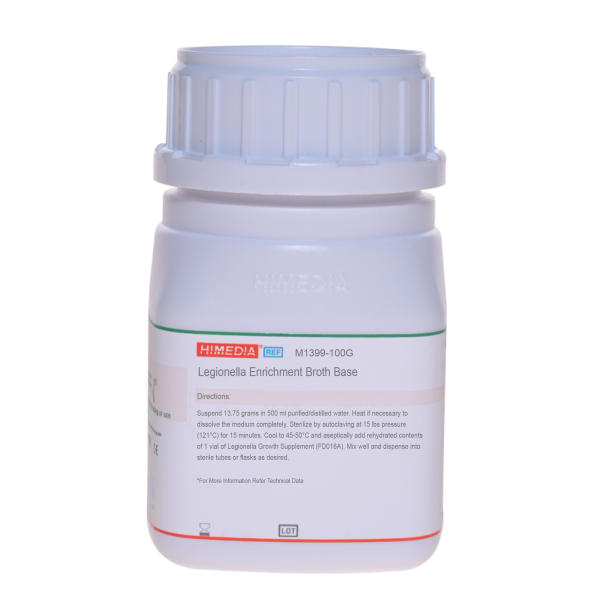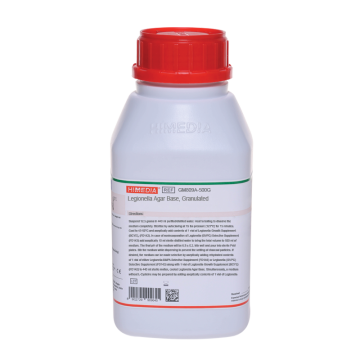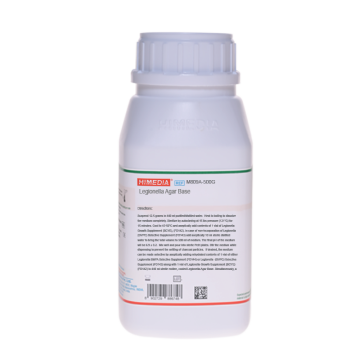 Your enquiry has been submitted
Your enquiry has been submitted
Legionella Enrichment Broth Base
Intended Use
With addition of supplements it is used for cultivation of Legionella species.
Composition**
| Ingredients | Gms / Litre |
|---|---|
| Yeast extract | 5.000 |
| Proteose peptone | 15.000 |
| HL extract # | 2.500 |
| Sodium chloride | 5.000 |
| Final pH (at 25°C) | 6.9±0.2 |
**Formula adjusted, standardized to suit performance parameters # Equivalent to Liver extract
Directions
Suspend 13.75 grams in 500 ml purified / distilled water. Heat if necessary to dissolve the medium completely. Sterilize by autoclaving at 15 lbs pressure (121°C) for 15 minutes. Cool to 45-50°C and aseptically add rehydrated contents of 1 vial of Legionella Growth Supplement (FD016A). Mix well and dispense into sterile tubes or flasks as desired.
Principle And Interpretation
Legionella is a gram-negative bacterium and is the causative agent of Legionnaires disease. Natural sources of Legionella are fresh water ponds and creeks. Transmission to humans takes place via inhalation of aerosols from cooling towers, hot water systems or fountains containing the bacteria. Legionella Enrichment Broth is recommended for enrichment of Legionella (2).
Yeast extract, HL extract and proteose peptone in Legionella Enrichment Broth Base provide necessary nitrogenous nutrients for better recovery of Legionella. Sodium chloride helps to maintain osmotic balance. L-Cysteine hydrochloride and ferric pyrophosphate satisfy the specific nutritional requirements. Adding 50 ml of sterile defibrinated horse blood can further enrich this medium.
Type of specimen
Water samples
Specimen Collection and Handling
For water samples, follow appropriate techniques for sample collection, processing as per guidelines and local standards (1). After use, contaminated materials must be sterilized by autoclaving before discarding.
Warning and Precautions
Read the label before opening the container. Wear protective gloves/protective clothing/eye protection/face protection. Follow good microbiological lab practices while handling specimens and culture. Standard precautions as per established guidelines should be followed while handling specimens. Safety guidelines may be referred in individual safety data sheets.
Limitations
- Further biochemical testing is required for complete identification.
Performance and Evaluation
Performance of the medium is expected when used as per the direction on the label within the expiry period when stored at recommended temperature.
Quality Control
Appearance Cream to yellow homogeneous free flowing powder
Colour and Clarity of prepared medium Yellow coloured clear to slightly opalescent solution in tubes
Reaction Reaction of 2.75% w/v aqueous solution at 25°C. pH : 6.9±0.2
pH
6.70-7.10
Cultural Response
Cultural characteristics observed with added Legionella Growth Supplement (FD016A), after an incubation at 35-37°C for 48-72 hours.
| Organism | Growth |
|---|---|
| Legionella dumoffii ATCC 33343 | good-luxuriant |
| Legionella pneumophila ATCC 33153 | good-luxuriant |
Storage and Shelf Life
Store between 10-30°C in a tightly closed container and the prepared medium at 2-8°C. Use before expiry date on the label. On opening, product should be properly stored dry, after tightly capping the bottle in order to prevent lump formation due to the hygroscopic nature of the product. Improper storage of the product may lead to lump formation. Store in dry ventilated area protected from extremes of temperature and sources of ignition. Seal the container tightly after use. Product performance is best if used within stated expiry period.
Disposal
User must ensure safe disposal by autoclaving and/or incineration of used or unusable preparations of this product. Follow established laboratory procedures in disposing of infectious materials and material that comes into contact with sample must be decontaminated and disposed of in accordance with current laboratory techniques (3,4).
Reference
- Baird R.B., Eaton A.D., and Rice E.W., (Eds.), 2015, Standard Methods for the Examination of Water and Wastewater, 23rd ed., APHA, Washington, D.C.
- Collee J. G., Duguid J. P., Fraser A. G., Marmion B. P., (Eds.), Mackie and McCartney, Practical Medical Microbiology, 1989, 13th Edition, Churchill Livingstone.
- Isenberg, H.D. Clinical Microbiology Procedures Handbook 2nd Edition.
- Jorgensen, J.H., Pfaller, M.A., Carroll, K.C., Funke, G., Landry, M.L., Richter, S.S and Warnock., D.W. (2015) Manual of Clinical Microbiology, 11th Edition. Vol. 1.
| Product Name | Legionella Enrichment Broth Base |
|---|---|
| SKU | M1399 |
| Product Type | Regular |
| Physical Form | Powder |
| Origin | Animal |
| Packaging type | HDPE |
| References | 1.Collee J. G., Duguid J. P., Fraser A. G., Marmion B. P., (Eds.), Mackie and McCartney, Practical Medical Microbiology,1989, 13th Edition, Churchill Livingstone. |
| Customized Product Available | No |








